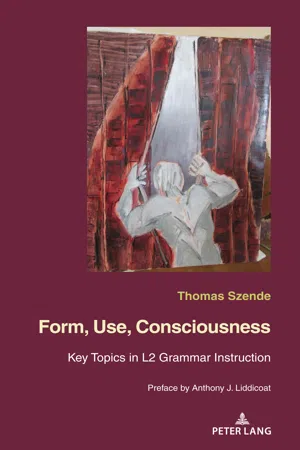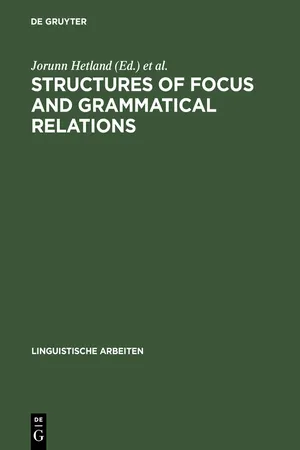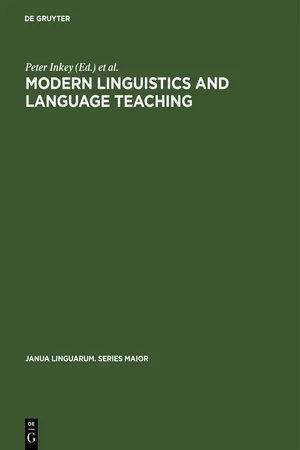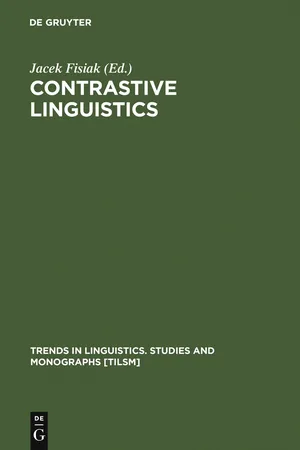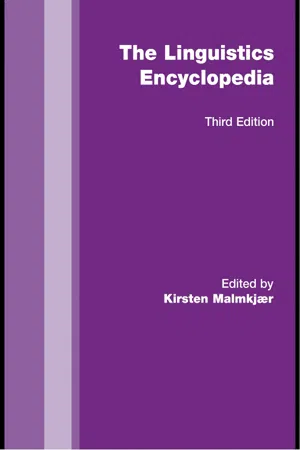Languages & Linguistics
Contrast
Contrast refers to the comparison of two or more things to highlight their differences. In linguistics, contrast is used to distinguish between sounds, words, or grammatical structures in a language. It is an important concept in phonology, morphology, and syntax.
Written by Perlego with AI-assistance
Related key terms
1 of 5
6 Key excerpts on "Contrast"
- eBook - PDF
Form, Use, Consciousness
Key topics in L2 grammar instruction With a Preface by Anthony J. Liddicoat (Professor of Applied Linguistics, University of Warwick)
- Thomas Szende(Author)
- 2020(Publication Date)
- Peter Lang Group(Publisher)
Such comparative work is developed through a linguistic journey to the L2. Summing up 30 years of research on second language immersion, Cummins (1998) concludes that educators should be conscious of the potential for enhancing students’ awareness of language by encouraging them to compare and Contrast aspects of their two languages. Grammar analysis allows comparisons to be made between structures within the same language, or between different languages. It soon becomes clear that when Contrasting two languages, the different ways of explaining an idea do not overlap. This Contrastivity is based on the assumption that while languages are different, it is possible to compare them using analytical grids. The idea is to establish potential, regular, and sometimes mandatory matches between the Contrasting languages. Explaining the points of convergence between two linguistic codes is just as important as identifying their points of divergence. Any grammar teaching sequence can be viewed (or not) from the perspective of the learner’s first language. One of the possible purposes of a grammar is to identify a language’s place among 190 Contrastive Analysis other world languages. Languages can explain each other. For example, since the verb “to have” does not exist in Hungarian, it is expressed by the dative-possessive -nak/-nek [to] + van/nak [there is/are] + a possessive suffix added to the noun (e.g., my, your, his). Katinak új háza van. KATI-DAT.-POSS. + NEW + HOUSE- POSS.SUFF.SG.3. + THERE IS = Kati has a new house. This structure may seem unusual compared to that of other Indo-European languages. Learners may also wonder about the number of elements it contains, since the possessor may not be explicitly stated in the sentence: Új háza van. NEW + HOUSE-POSS.SUFF.SG.3. + THERE IS = [She] has a new house. - Jorunn Hetland, Valéria Molnár, Jorunn Hetland, Valéria Molnár(Authors)
- 2013(Publication Date)
- De Gruyter(Publisher)
In recent literature, there have been important attempts at critical investigation of the notions serving as starting points for cross-linguistic comparisons. 2 One of the areas where there is still work to be done, will be central to my discussion in the following: the domain and the concept of Contrast. With Contrast and Contrastivity as a frame, the main focus of my paper will be on a more specific subject, on the fall-rise accent, which contributes to what has been called 'Contrastive topic' and 'Contrastive focus' (in one sense of the latter term) in the literature. My aim has been to find out more about the special quality of Contrast associated with this accent, and to examine the relations between the fall-rise-Contrast and other relevant types of 1 Other terms that have been used for (approximately) the same concept as 'Contrastive Focus' (Horvath 1986, Kenesei 1998) are 'Operator Focus' (É. Kiss 1995, Molnár 1998), 'Identifi-cational Focus' (É. Kiss 1998) and 'Kontrast' (Vallduví/Vilkuna 1998). 'Information Focus' is related to 'Presentational Focus' (Rochemont 1986, Horvath 1986, Kenesei 1998) and to Vallduvi/Vilkuna's (1998) term 'Rheme'. 2 Important contributions are Molnár (1998), Roberts (1998), Vallduví/Vilkuna (1998), Gundel (1999) and Molnàr/Jârventausta (this volume). 2 Jorunn Hetland Contrast. The connections between fall-rise-accented constituents and the information struc-tural categories topic and focus have been another important issue throughout. 1. On accent, Contrast and possible alternatives There is no Contrastive accent as such, Pike (1945: 45) states in his monograph The into-nation of American English. A similar view is maintained by Bolinger (1961: 87): [...] as far as we can tell from the behavior of pitch nothing is uniquely Contrastive.- eBook - PDF
Modern Linguistics and Language Teaching
Society for the Popularization of Sciences – T.I.T./Fédération Internationale des Professeurs de Langues Vivantes – F.I.P.L.V., International Conference Budapest, April 1–5, 1971
- Peter Inkey, György Szépe, Peter Inkey, György Szépe(Authors)
- 2018(Publication Date)
- De Gruyter Mouton(Publisher)
100 PROBLEMS AND PROSPECTS IN ContrastIVE LINGUISTICS Deficiencies in theory and methodology 1 Among the obvious causes of the cited shortcomings are the following: a) Weaknesses in the principles of Contrastive linguistics: A fundamental precept of Contrastive linguistics is derived from transfer theory, a theory currently in disrepute among many psychologists and, in any case, probably inapplicable to the complexities of the language-learning situation. Moreover, the form in which it is understood by many Contrastivists — that prior learn-ing affects subsequent learning, positively when the learning tasks coincide and negatively where they differ — is described as a gross oversimplification by psychologists. b) Logical contradictions within these principles: The linguist's procedures in comparing two language structures cannot be analogous to the learner's reactions in making associations between the systems. The latter's exposure to the target language is necessarily gradual, a fact entailing a dilemma for Contrastive linguistics since what the learner learns of the target language becomes part of his prior conditioning, along with his first language, in any further learning. In not taking account of this fact, therefore, Contrastive linguistics violates its own fundamental premise, and predictions and explana-tions based solely on a comparison of the base and target system must often necessarily fail. A learner of English who has mastered the productive verbal and nominal paradigms might be expected to employ forms like bringed and mouses, while different learning sequences might produce tooken or brang — in all cases interference of internal origin, not derived from the source language. - eBook - PDF
Contrastive Linguistics
Prospects and Problems
- Jacek Fisiak(Author)
- 2011(Publication Date)
- De Gruyter Mouton(Publisher)
NILS ERIK ENKVIST Contrastive linguistics and text linguistics 0 The overall title of the volume harbouring my paper is Contrastive linguis-tics: prospects and problems. The broad range of this title is a hint for me to contribute a general overview of a very comprehensive set of problems, rather than to bore deep into some specific detail. I shall try to map some areas in which Contrastive and text linguistics overlap, and discuss a few of the con-crete questions that have come to the fore in the past several years. My paper will fall into four parts. In the first section I shall attempt a nutshell survey of the state of the art in text linguistics, in terms of four types of text models that are in current use. In the second section I shall very briefly list some types of Contrastive problems that can be investigated with the aid of these different models. In the third part I shall once again raise the complex ques-tion of models and parameters in Contrastive word-order studies. And in the fourth section I shall, again briefly, make some programmatic remarks about views of language as structure and language as process, insofar as this distinc-tion seems to bear on Contrastive linguistics. 1 It is by now a truism that all Contrastive linguistics must be based on some theory and model of linguistic description. Without such a foundation we simply cannot compare and Contrast languages in a systematic way. It is an-other matter that in applied Contrastive work the approach may well be eclec-tic; picking and choosing among different theories and models and perhaps, if so desired, even using different theories for different areas of work. Those to whom applied linguistics is an eclectic discipline will hardly be shocked when linguists change models, like horses, in mid-stream. To get started, from a considerable height let me give a bird's-eye view of some major types of text models that have been offered in text and discourse linguistics 1 over the past decades. - Okim Kang, Ron I. Thomson, John M. Murphy, Okim Kang, Ron I. Thomson, John M Murphy, John M. Murphy, Okim Kang, Ron I. Thomson, John M Murphy(Authors)
- 2017(Publication Date)
- Routledge(Publisher)
Historical and theoretical perspectives on pronunciationPassage contains an image
John Archibald1 Transfer, Contrastive analysis and interlanguage phonologyIntroduction
As with any field that has been active for over half a century, the technical terms found within it are both precise and, simultaneously, laden with connotation. In this chapter, I have purposefully used traditional terms in the title because I think they provide a fine vehicle for surveying some of the key issues in both the history and future of the discipline.Historical and current conceptualizations
As Stern (1983) showed, much of the history of the study of second language learning was, in fact, more focused on second language teaching . There was much concern as to which teaching method was the best. Gradually, this emphasis began to shift as the field of second language acquisition (SLA) emerged, and more attention was paid to the learner. For the benefit of newcomers to the area, let me begin by setting out the timeline by introducing key terms.Transfer : It has long been widely recognized (e.g. Gass & Selinker, 1983) that second language (L2) production is influenced by properties of the first language (L1). Surface level elements were the focus of descriptions of L2 production (either spoken or written).Contrastive analysis : In an effort to determine why some learners were not learning some elements, the method of Contrastive analysis (Lado, 1957) attempts to describe or explain what was called ‘non-learning’. At this point, it would be worth pointing out that the work in language teaching, or applied linguistics, or educational linguistics, was not isolated from other academic disciplines (such as psychology). At the time when Contrastive analysis was first proposed (see Archibald, 1993, for discussion), the dominant theory of learning was behaviourism (an extreme form of empiricist learning theory). Such an account places the emphasis on the environment as the driver of learning and highlights the role of feedback as the driver of change in the learner. From this perspective, the goal is to design the best learning environment (i.e. classroom) to ensure that learning takes place. Following a behaviourist paradigm of learning as habit formation within a model of stimulus/response, there was no place in the discipline for what was known as mentalism- eBook - ePub
- Kirsten Malmkjaer(Author)
- 2009(Publication Date)
- Routledge(Publisher)
pair of languages), and founded on the assumption that languages can be compared’ (James 1980: 3). Contrastive analysis traditionally has an applied perspective, branching into translation studies as well as language pedagogy. However, Contrastive analysis may also be more theoretically orientated, e.g., by investigating how a universal category X is realised in languages A and B (Fisiak 1981: 2). Contrastive/ cross-linguistic studies are not dependent on any particular theoretical framework. However, they tend to involve only a small number of languages, typically a pair, in Contrast to studies of universal grammar or language typology.Any fruitful comparison presupposes that the items compared have something in common (cf. Krzeszowski 1995: 9). A central concern of Contrastive linguistics is thus that of identifying an appropriate tertium comparationis, i.e. a ‘third term’ that can provide a frame of reference for the comparison. Various types of tertia comparationis have been suggested and used: formal (similarity of form or of grammatical categorisation), semantic (similarity of meaning) and functional (similarity of communicative purpose, genre etc.) (see Chesterman 1998). Particularly in connection with the use of parallel corpora (see below), the notion of translation equivalence has been advocated as a tertium comparationis ( James 1980: 178; Johansson 2007: 3).The Contrastive analysis hypothesis
Contrastive methods have a long history in linguistics (e.g., Weil 1844; Mathesius 1935/1961), and Krzeszowski (1995) gives examples that go back to the Renaissance. Contrastive analysis as a branch of applied linguistics, however, was developed in the USA in the 1940s and 1950s (see e.g., Fries 1945 and Lado 1957). The motivation for this work was foreign-language teaching and the development of teaching materials: ‘The most efficient materials are those that are based upon a scientific description of the language to be learned, carefully compared with a parallel description of the native language of the learner’ (Fries 1945: 9); ‘in the comparison between native and foreign language lies the key to ease or difficulty in foreign language learning’ (Lado 1957: 1). Such a view of the role of Contrastive analysis gave rise to the strong version of the Contrastive analysis hypothesis (Wardhaugh 1970); i.e. the belief that difficulties in learning a language can be predicted on the basis of a systematic comparison of the system of the learner’s first language (its grammar, phonology and lexicon) with the system of a second language. A weaker version of the Contrastive analysis hypothesis is based on ‘evidence of language interference’ (Wardhaugh 1970: 123) and is thus related to error analysis
Index pages curate the most relevant extracts from our library of academic textbooks. They’ve been created using an in-house natural language model (NLM), each adding context and meaning to key research topics.
